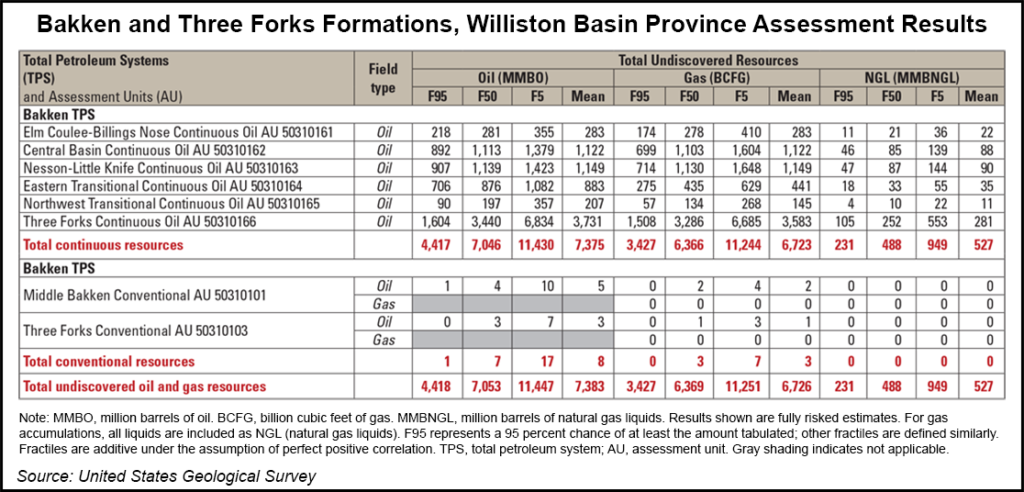NGI Archives | NGI All News Access
USGS: Three Forks Multiplies Bakken’s Resource Potential
The Bakken Shale and Three Forks formation in the Williston Basin in Montana, North Dakota and South Dakota contain a combined estimated 7.4 billion bbl of undiscovered, technically recoverable oil, 6.7 Tcf of undiscovered, technically recoverable natural gas and 530 million bbl of undiscovered, technically recoverable natural gas liquids (NGL), according to an assessment released Tuesday by the United States Geological Survey (USGS).

Those numbers are up significantly compared with a 2008 USGS assessment of the Bakken — twice as much oil and three times as much natural gas and NGL as the previous study — because of the inclusion of the Three Forks formation in the new assessment. The Three Forks formation lies below the Bakken Shale.
In its 2008 study of the Bakken, USGS estimated mean undiscovered volumes of 3.65 billion bbl of oil, 1.85 Tcf of natural gas and 148 million bbl of natural gas liquids. That oil figure — a 25-fold increase over a 1991 assessment of 151 million bbl of oil — represented the largest amount ever assessed by the federal government and the largest in the Lower 48.
The Bakken’s numbers stayed about the same, “but it’s a little more complicated than that,” said USGS Energy Resources Program Coordinator Brenda Pierce.
“We did do a lot of work on the Bakken,” Pierce said. “We looked at all the new industry data — the new practices in use there — [and] we understood the geology a little bit better, and so even though the number is the same, it’s important to understand that because we’re looking at the undiscovered resources, all of that production since our last assessment and all of those new reserves that are being booked as reserves are excluded from this new number. So even though it’s still 3.65 [billion bbl], that number’s actually bigger because it’s additive to all of those reserves and what’s been produced since that time.”
“This is clearly great news for North Dakota and great news for the nation,” said Sen. John Hoeven (R-ND). “It will further serve to enhance our state’s role as an energy powerhouse for the nation…This new USGS study further confirms and reinforces the fact that the Williston Basin is a sustainable, long-term play warranting strong private-sector investment for decades into the future.”
Technically recoverable resources are those producible using currently available technology and industry practices.
“The USGS assessed the undiscovered but technically recoverable resources using today’s technology and industry practices. The undiscovered resources are postulated on the basis of geologic knowledge and theory, but they do not include the known fields or those fields currently in production,” said Suzette Kimball, USGS acting director.
The Three Forks was not included in the 2008 assessment “because, with a few exceptions, it was generally thought to be non-productive, and there was almost no data on it,” Kimball said. “There has been much more interest it; industry has gone down into the Three Forks since then…when we started this reassessment, all these new data were coming out from the Three Forks and since then there’s just been an explosion. There’s still tremendous development in the Bakken, but the Three Forks is up and coming.”
Since the 2008 assessment, more than 4,000 wells have been drilled in the Williston Basin, providing updated subsurface geologic data. “Previously, very little data existed on the Three Forks Formation, and it was generally thought to be unproductive,” said USGS. “However, new drilling resulted in a new understanding of the reservoir and its resource potential.”
The report also included a high-end estimate of as much as 11.4 billion bbl of undiscovered, technically recoverable oil, 11.2 Tcf of undiscovered, technically recoverable natural gas and 949 million bbl of undiscovered, technically recoverable NGLs, though USGS said there is only a 5% chance of those amounts proving to be true.
“Assessments like these are typically more conservative because technology changes so rapidly,” said Lynn Helms, director of the North Dakota Department of Mineral Resources. “We agree with the range of numbers and think the high estimate of 11 billion bbl is a reasonable target as technology and exploration of the Three Forks continues.”
The primary source of oil for the Bakken and Three Forks Formations are the Upper and Lower Bakken Shale Members of the Bakken Formation. USGS assessed the Bakken and Three Forks formations for both continuous and conventional resources. Unlike conventional oil accumulations, continuous oil remains in or near the original source rock, and instead of occurring in discrete accumulations is dispersed heterogeneously over large geographic areas.
Data was provided by the North Dakota Geological Survey, North Dakota Industrial Commission, Montana Board of Oil and Gas, and industry groups working in the region.
USGS began its study of the Bakken and the Three Forks formation in 2011 (see Shale Daily, May 24, 2011).
© 2024 Natural Gas Intelligence. All rights reserved.
ISSN © 2577-9877 | ISSN © 2158-8023 |

